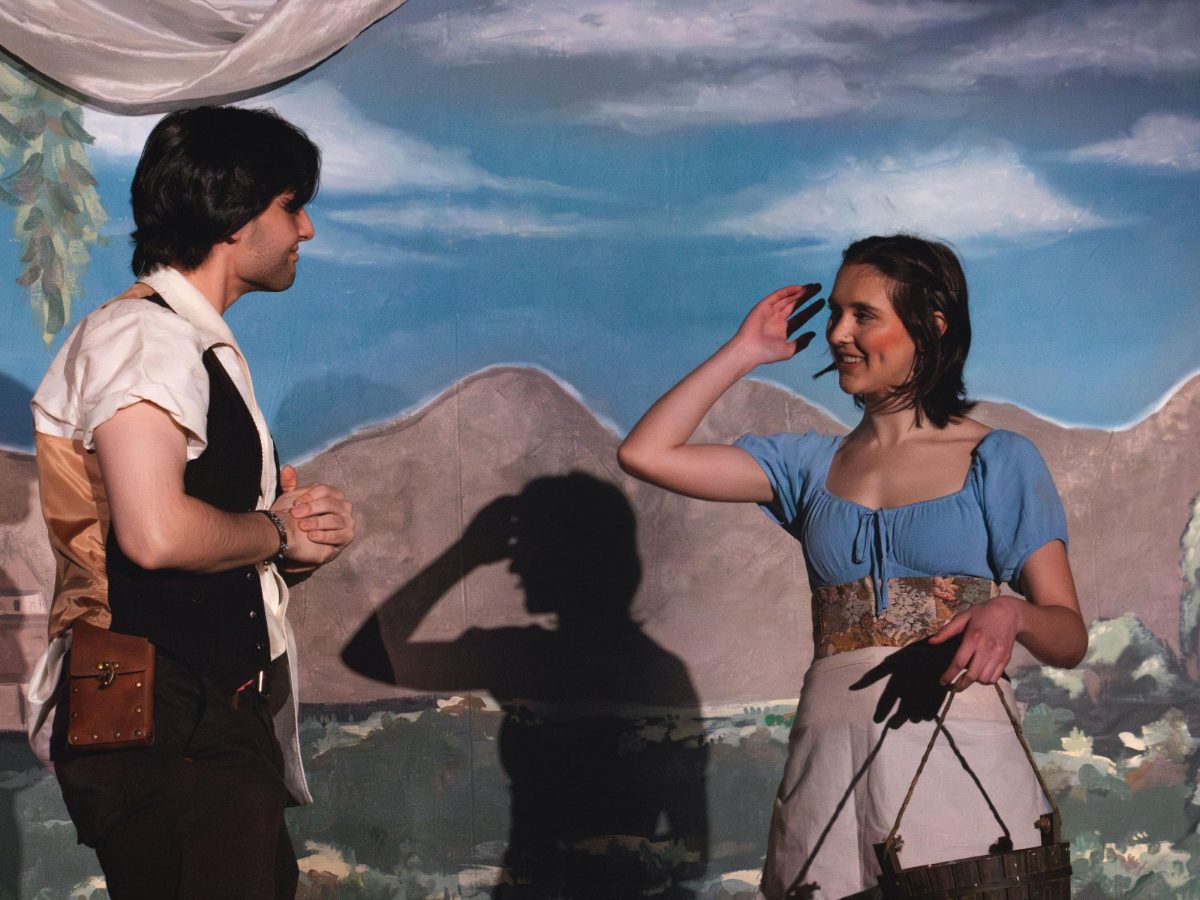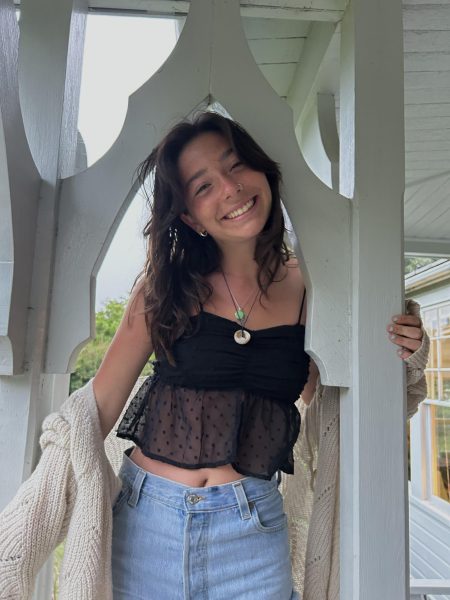Walking down Moss Street into quiet, sloping East Campus, a mini library and arches mark the Grove Community Garden. Entering on newly mulched paths, you’ll pass raised beds, a camper van full of supplies and the garden cat GG who welcomes everyone and anyone. With fresh soil and herbs hanging heavy in the air, laughter and questions swirl around a small community farm just blocks away from the bustle and stress of campus.
Amidst the limited spaces available for intentional communities and ongoing initiatives by the University of Oregon to reclaim such areas, there is a concerted effort to expand spaces for students. One such effort is growing the Grove Garden. Led by the Student Sustainability Center, it aims to not only provide students with valuable gardening experience, but also establish a reciprocal environment where students contribute to the land and actively nourish the wider community.
However, spaces like the Grove Garden are not permanent, and the $225 million building overshadowing the Urban Farm symbolizes that reality. Since 1976, students and locals alike have cultivated kale, sunflowers, asparagus and several other plants at the Urban Farm, just across Franklin Boulevard. Now that drills and saws shriek through the air, meeting on the farm requires yelling over the sound of construction — a sad afterthought of the development of the Phil and Penny Knight Campus.
Long before construction began in early 2022, many students, faculty and community members organized to fight these plans through a coalition called Save the Urban Farm. They sought to obtain information about Phase 2, a proposed multistory, 173,000-square-foot bioengineering building, and share this information with the UO community, but transparency proved difficult. Formal design plans were supposed to be available following a UO Campus Planning Committee meeting on April 29, 2022; however, discussion about Phase 2 was removed from the meeting agenda.
Madison Sanders, an organizer of Save the Urban Farm and UO student who sits on the Campus Planning Committee, says Phase 2 could have been removed from the meeting agenda for many reasons, such as scheduling conflicts or the design team needing more time to finalize plans. Still, she says obtaining clear answers was a challenge, as previously reported by Ethos.
Throughout the vibrant spring and sun-kissed summer months in Eugene, the coalition gathered testimonies and ignited rallies, each echoing the Urban Farm’s verdant beauty. Despite their campaign, they witnessed no progress. Construction began under floodlights at 4 a.m. on Dec. 19, 2022 — weeks ahead of what was told to supporters, continuing on and around the Urban Farm to date.
All told, university encroachment caused the loss of 35 orchard trees, around a dozen Port Orford Cedar Trees and 40% of the farm’s plantable garden beds. While a place for holding classes, the Urban Farm also produced 20,000 pounds of food annually that went directly to students through the Student Food Pantry.
Jackson Klingelhofer, a sophomore studying landscape architecture and assistant for the Food and Garden First-Year Interest Group, witnessed how the Phil and Penny Knight Campus has disrupted this space.
“The Urban Farm is not only a place where I learned a lot about my major and about urban agriculture. I made a lot of connections at the Urban Farm — I met some of my best friends at the Urban Farm,” Klingelhofer says. “We were able to bond over the fact that we were being productive together, we were learning about farming and growing things together.” With less area for people to gather and experience the garden, he says the Urban Farm has become less inviting since Phase 2 started.
“I hope we can find other spaces around Eugene to create more of those community spaces because I think they’re very important for student life as well as for people to find their place in Oregon,” says Klingelhofer.
Although the Urban Farm is still functioning and an important part of campus life, it is not the same. Encouraging initiatives aimed at safeguarding spaces like the Urban Farm is crucial to ensure the longevity of intentional communities. Klingelhofer and others envision the Grove as a place poised for growth.
But like the Urban Farm, university expansion also threatens the Grove under what’s called the Next Generation Housing Plan. During a meeting on March 10, 2024, architects suggested pushing campus south and east of Kalapuya Ilihi Hall, adding multiple housing structures with 2-7 stories. While the timeline is still up to change, the university expects to finalize plans by summer 2024 and start construction the following summer.
This threat rings warning bells for those who experienced the loss of the Urban Farm. Many see the university as prioritizing innovation, development and growth over the lives of students and the community. Valentine Bentz, a junior at the University of Oregon, Climate Justice League member and Growing Grove Garden lead, is among those concerned.
“I think us being caretakers, being part of the space and hearing about development is initially jolting — like, oh my gosh, just like an enemy,” says Bentz. “It’s how we posture ourselves and work with development that’s going to really affect things and what it’s going to affect, like whether our space is there or not.”
So Grove volunteers have started to prepare. By attending public-facing meetings with the Campus Planning Committee, giving feedback and voicing concerns, the Grove has already produced some change. “We’ve already seen them actually mark the garden on the maps, which I don’t believe it previously was,” says Bentz. “They really pointed out at that meeting that our space will be given consideration within the development process.”
But the Grove’s organizing extends far beyond simply attending meetings. From bed planning events, work parties on Saturdays, compost bucket decorating and constant room for engagement, the Grove is pushing to be heard and seen by the greater Eugene community.
Chelsey Groves, a freshman at UO and Grove Garden volunteer, has found much importance in her work at the garden. “I love not only gardening but that the garden also tries to incorporate a lot of art into the space,” says Groves.
In the heart of the Grove, amidst the lush greenery and vibrant blooms, lies a special bed dedicated solely to art. Volunteers like Groves nurture plants, carefully cultivating materials destined to become pigments for paint. Imagine bursts of sunshine yellows and delicate pinks, each hue nurtured from seeds volunteers watered, blooming under the Oregon sky. The Grove transforms into more than just a space for growing food; it becomes a living canvas where the scent of earth mingles with the promise of creativity.
Bad weather or not, the Grove community works to include and hold space for all. Collage nights filled with old recycled magazines, the smell of glue permeates and Mort Garson’s album “Mother Earth’s Plantasia” hums in the background as members chat, create vision boards and drink lots of tea.
Apart from educating, building community and encouraging creativity, organizers at the Grove guide these events based on several other core values: reciprocity, embeddedness in place, regeneration and food justice.
“The regenerative model in plain terms is just a model that provides benefit to the land you’re working with, as opposed to just taking from it. Reciprocity implies you’re both benefiting if there are two parties. Our regenerative model relies on helping the land and the land is helping us by producing food and space” says Bentz. “In the Western world, we tend to extract from the land. Even in ways where it’s produced for us, we’re not exactly treating it as an entity that needs to come into the exchange in a way that it’s like another party.”
By pursuing a regenerative model, the gardeners and volunteers are enhancing soil health, making it more fertile and increasing the amount of native plants they have in the space. For instance, the Grove implements companion planting. Instead of relying on monoculture and keeping plant species separate, volunteers are learning what species can cohabitate and help each other. Bentz described how the team planted kale and Swiss chard intermixed with dill, which has a fragrance that wards off pests and bugs. The Grove also collects compost donated by students and community members, using it to reinvigorate the soil and help it produce more.
As with any functional community, the Grove respects and understands that people have different levels of commitment, using clever slogans to designate different positions, the first of which is called sowing seeds. Volunteers who are sowing seeds can show up to any event and participate as long as they can. Then there’s a lead, or people who show more interest and show up regularly. They get the opportunity to coordinate events and projects that get done on and around the grove.
Bentz emphasizes that the process is far more important than the outcome. “You can do everything right, and a seed still might not germinate and might not grow — you might get nothing out of it,” he says. “You might respond by not valuing the outcome as much, but going by what you’ve learned along the way.”
As urbanization continues to expand, traditional agricultural practices face limitations in space and resources. Urban farming, however, transforms unused or underutilized spaces into vibrant hubs of food production. The Grove offers a new way of life with initiatives and lessons, while simultaneously providing fresh and locally sourced produce to students and the community through the community garden.
“We want to build these inclusive working communities that will take us into more just futures as things prove to be more and more ineffective,” says Bentz. “We have these communities where we can sustain each other, be there for each other and support each other”
The Grove Garden and the Urban Farm are also actively tackling food insecurity in Eugene, making these spaces especially crucial. Over one in five UO students were food insecure in the 2020-21 academic year, which was double the national rate, according to a report from UO’s Student Wellbeing and Success Initiative. Since 2020, the national rate of food-insecure students increased from 10.5% to 23%.
By decentralizing the food supply chain, urban farming reduces carbon emissions from transportation while promoting food security and resilience. Embracing this alternative lifestyle contributes to ecological well-being and redefines the relationship between urbanites and their food sources, paving the way for a more sustainable and interconnected future.
“When I first started working at the garden, I was in a place where I was food insecure. I obviously wasn’t getting massive, massive amounts of produce, but it certainly was really humanizing to be able to grow or to be able to get food that was grown in my community when I was struggling,” Bentz says. “I think there’s probably a lot of folks who come and volunteer who probably are somewhere along that spectrum of having food needs, and the garden can help meet those immediately in some sort of exchange.”
The Grove set aside several plots to donate to the student food pantry, including three full plots of fava beans. When harvesting comes around, volunteers plan to package the beans with cards that have cooking advice, each handwritten by their picker.
“The connection to land and earth you can have when you actually plant a seed, it grows and you eat the food from it is an experience that almost no one has the opportunity to experience,” says Bentz. “People are generally not connected to the food they eat, and it’s such an incredible starting point to build community. It’s something I’ve experienced here — it’s what keeps people coming back, including me.”








![[Photo Courtesy of the Lara Family]
Ruben embraces his beloved childhood goat, Katrina.](https://ethos.dailyemerald.com/wp-content/uploads/2025/05/katrina-1-1060x1200.jpg)









